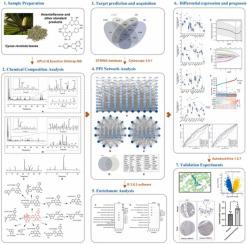Industrial Crops and Products ( IF 5.6 ) Pub Date : 2023-06-08 , DOI: 10.1016/j.indcrop.2023.116967 Qinyun Du , Nan Xing , Sa Guo , Xianli Meng , Yi Zhang , Shaohui Wang

|
Cycas revoluta Thunb. (CR) is a widely distributed ornamental and economical plant, and its seeds are important sources of starch and β-cyclodextrin production. However, the medicinal value of CR leaves should also be considered, because flavonoids in CR leaves could represent a possible substance basis for the treatment of lung adenocarcinoma (LUAD). Oxidative stress (OS) and inflammatory immune response (IIR) have been reported to be associated with tumorigenesis and tumor progression. In this study, for the first time, Ultra-high-performance liquid chromatography-quadruple-electrostatic field orbitrap high resolution mass spectrometry (UPLC-Q Exactive Orbitrap-MS) method was used to systematically analyze the chemical profile of CR leaves, and characteristic fragment ions and fragmentation patterns of flavonoids obtained from CR. leaves was analyzed. Subsequently, network pharmacology and molecular docking methods were applied to explore the underlying central targets and related pathways of the targeted regulation of OS and IIR by flavonoids in CR leaves. Consequently, A total of 62 components were characterized from CR. including 10 flavonoids, which were (-)-epigallocatechin, amentoflavone, bilobetin, catechin, ginkgetin, hinokiflavone, naringenin, podocarpusflavone A, sciadopitysin, and vitexin respectively. The hub targets of these 10 flavonoids from CR in treating LUAD was narrowed in Fms-like tyrosine kinase 3 (FLT3), Cyclin A2 (CCNA2), Cyclin B1 (CCNB1), Insulin-like growth factor-binding protein 3 (IGFBP3), Peroxisome proliferator-activated receptor-γ (PPARG), Catalase (CAT), and Myeloid cell leukemia-1 (MCL1). Among them, amentoflavone and podocarpusflavone A have shown great therapeutic potential, while CAT and CCNA2 can be used as potential markers for future studies of flavonoids in CR leaves against LUAD from the perspective of OS and IIR. Taken together, the results showed that flavonoids in CR leaves are potential sources of anti-LUAD compounds by targeting OS and IIR, which will offer a scientific insight for the exploitation and application of CR leaves as functional resources and also provide methodological references for the deeper development of other cash crops.
中文翻译:

苏铁叶:作为靶向调节肺腺癌免疫相关标志物的潜在类黄酮来源
苏铁。(CR)是一种分布广泛的观赏和经济植物,其种子是淀粉和β-环糊精生产的重要来源。然而,还应考虑 CR 叶的药用价值,因为CR 叶中的类黄酮可能代表治疗肺腺癌 (LUAD) 的可能物质基础。氧化应激据报道,(OS)和炎症免疫反应(IIR)与肿瘤发生和肿瘤进展有关。本研究首次采用超高效液相色谱-四重静电场轨道阱高分辨质谱(UPLC-Q Exactive Orbitrap-MS)方法系统分析了CR叶的化学特征,以及特征从 CR 中获得的类黄酮的碎片离子和碎裂模式。叶子进行了分析。随后,应用网络药理学和分子对接方法探索 CR 叶中黄酮类化合物靶向调控 OS 和 IIR 的潜在中心靶点和相关途径。因此,共有 62 个组件从 CR 中得到表征。包括 10 种黄酮类化合物,它们是 (-)-表没食子儿茶素,amentoflavone 、bilobetin、儿茶素、银杏黄酮、hinokiflavone、柚皮素、罗汉松黄酮 A、sciadopitysin 和牡荆素。来自 CR 的这 10 种黄酮类化合物在治疗 LUAD 中的中枢靶点在 Fms 样酪氨酸激酶 3 (FLT3)、细胞周期蛋白 A2 (CCNA2)、细胞周期蛋白 B1(CCNB1)、胰岛素样生长因子结合蛋白 3 (IGFBP3)、过氧化物酶体增殖物激活受体-γ (PPARG)、过氧化氢酶 (CAT) 和骨髓细胞白血病-1 (MCL1)。其中,杏仁黄酮和罗汉松黄酮A已显示出巨大的治疗潜力,而CAT和CCNA2可作为未来从OS和IIR角度研究CR叶中黄酮类化合物对抗LUAD的潜在标志物。综上所述,该结果表明,CR叶中的黄酮类化合物是靶向OS和IIR的抗LUAD化合物的潜在来源,这将为CR叶作为功能资源的开发和应用提供科学见解,也为更深入的研究提供方法学参考。发展其他经济作物。











































 京公网安备 11010802027423号
京公网安备 11010802027423号